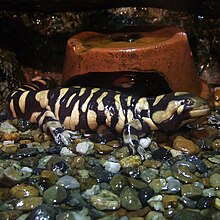Barred tiger salamander
| Barred tiger salamander | |
|---|---|
 |
|
| Scientific classification | |
| Kingdom: | Animalia |
| Phylum: | Chordata |
| Class: | Amphibia |
| Order: | Caudata |
| Family: | Ambystomatidae |
| Genus: | Ambystoma |
| Species: | A. mavortium |
| Binomial name | |
|
Ambystoma mavortium Baird, 1850 |
|
The barred tiger salamander or western tiger salamander (Ambystoma mavortium) is a species of mole salamander found from southwestern Canada in British Columbia, Alberta, Saskatchewan, and Manitoba, south through the western United States to Texas and northern Mexico.
The barred tiger salamander typically grows from 15 to 22 cm (5.9 to 8.7 in) but it can grow to 30.5 cm (12.0 in) long at the most and is one of the largest species of salamander in North America. It has a broad head and a sturdy body. The color is variable across its range. The dorsal surface is grey, dark brown or black with bars and spots of muddy yellow giving it a tiger-like coloring. The ventral surface varies from light to dark. Larvae have alternating dark and light blotches on the centre of the dorsal surface and pale stripes running along the sides.
Primarily nocturnal, barred tiger salamanders are opportunistic feeders, and will often eat anything they can catch, including various insects, slugs, and earthworms. They are primarily terrestrial as adults, but their juvenile larval stage is entirely aquatic, having external gills. Breeding takes place during most months of the year. The eggs are laid in water and the developing larvae are aquatic. There have been reports of cannibalism in this species but it seems to vary in extent in different parts of its range.
The five recognized subspecies of A. mavortium are:
The barred tiger salamander is found in western Canada and the western half of the United States, but infrequently in California and Nevada. In Canada it is known from British Columbia, Alberta, Saskatchewan and Manitoba. Its range in the United States extends to the southernmost tip of Texas, but no further east than the Dakotas and Oklahoma. It has been introduced into southern Arizona because its larvae are used as fish bait. It is a mainly terrestrial species and is found in lowland deciduous forests, coniferous forests and woodlands. It also inhabits open fields and rough ground, upland meadows, grasslands, semi-deserts and deserts and is occasionally found in streams.
...
Wikipedia
